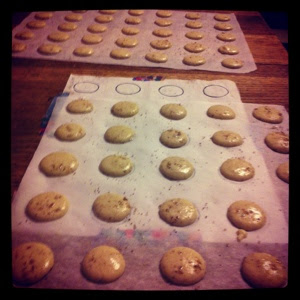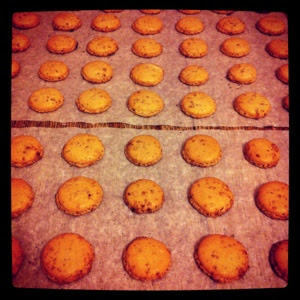Caramel is a tricky filling for macarons; it's a little too gushy on its own. Caramel flavoured frostings are often a little anemic and flavourless. I tried to make these strongly flavoured, deeply caramely and pointedly salty. You can reduce the salt if your sucré-salé tastes lean a little more to sucré. I like to taste the salt.

Macarons are notoriously finicky but there are a few things that seem to help them turn out more consistently.
Cooking notes:
When making macarons, it is important to use absolutely clean and dry bowls, whisks, spatulas. If a drop of water or grease gets into the egg whites, they will not whip up properly.
If you are using whole eggs, separate them in advance, preferably a day in advance, and store them in the fridge an airtight container. Bring to room temperature before using.
I prefer to use boxed egg whites, which don't need to be aged and avoid wasting lots of yolks.
I recommend that you make a size template to work from on a sheet of white paper. Trace 1.5 inch circles, evenly spaced, onto a piece of paper. Place it under the parchment before piping the macaron shells to follow for size and spacing.
The resting phase after piping the batter helps the macarons form feet properly by drying them out slightly. This way the whole outer skin lifts away when baking and allows feet to form .
Folding the dry ingredients into the whipped egg whites is called macaronage. It is important not to under or over mix the batter. Under mixing will result in macarons which are not smooth and have a texture too much like a traditional meringue. Over mixing will result in a too loose, runny batter.
Macaron shells:
adapted from canelle et vanille
100 grams egg white
50 grams granulated sugar
110 grams almond flour
190 grams powdered sugar
1/2 tsp vanilla powder, or innards of 1/2 vanilla bean
vanilla salt (flaky salt mixed with a generous pinch of vanilla powder)
Mix together almond flour, vanilla powder and powdered sugar and sift or whisk thoroughly to avoid clumps. Set aside.
In a stand mixer bowl whisk egg whites on high speed. Add granulated sugar a little at a time. Mix until the eggs form stiff peaks.
Fold almond mixture into meringue gently. Keep an eye on the texture of the batter. You are aiming for flowing not runny. It is correct when a spoonful of batter slowly smooths itself when dropped on a plate. If it doesn't smooth into a glossy dome it needs more folding; if it smooths out very quickly, it is probably over mixed.
Fill a piping bag fitted with a large round piping tip with batter. Pipe onto parchment paper, following your template. Pipe the batter slightly smaller than the template; they will spread slightly. Sprinkle vanilla salt over piped cookies. Leave them for about an hour to dry.
Bake for 10 minutes in a 300 degree oven, turning once to brown evenly. If the shells stick to the parchment paper, cook for a couple more minutes.

Salted Caramel adapted from Chubby Hubby
200 grams sugar
200 grams cream
150 grams butter
generous pinch of fleur de sel, or two or three
pinch of vanilla powder
Melt sugar in a medium pot over medium high heat, stirring constantly. When the sugar has melted and reached a nut brown colour, remove from heat and slowly add cream. The caramel will bubble vigorously and maybe seize a little. Lower heat and stir pot until sugar melts again. Add the butter, salt and vanilla and stir until butter melts. Chill caramel in the fridge before adding to frosting.
Salted caramel buttercream:
1/3 cup butter
3 cups icing sugar
1-2 tbs milk
salted caramel
Slowly cream together sugar and butter, adding milk a tablespoon at a time, to make a stiff buttercream. When combined, turn mixer up to high speed and cream for a couple more minutes until fluffy. Add salted caramel a little at a time. The aim is to add as much caramel as possible without making the buttercream too runny. It's a balance; add a little caramel at a time, whip and then add a little more.
Pipe frosting onto macaron shells and sandwich together. They are best after a day resting in the fridge. Let the macarons come to room temperature before serving.


